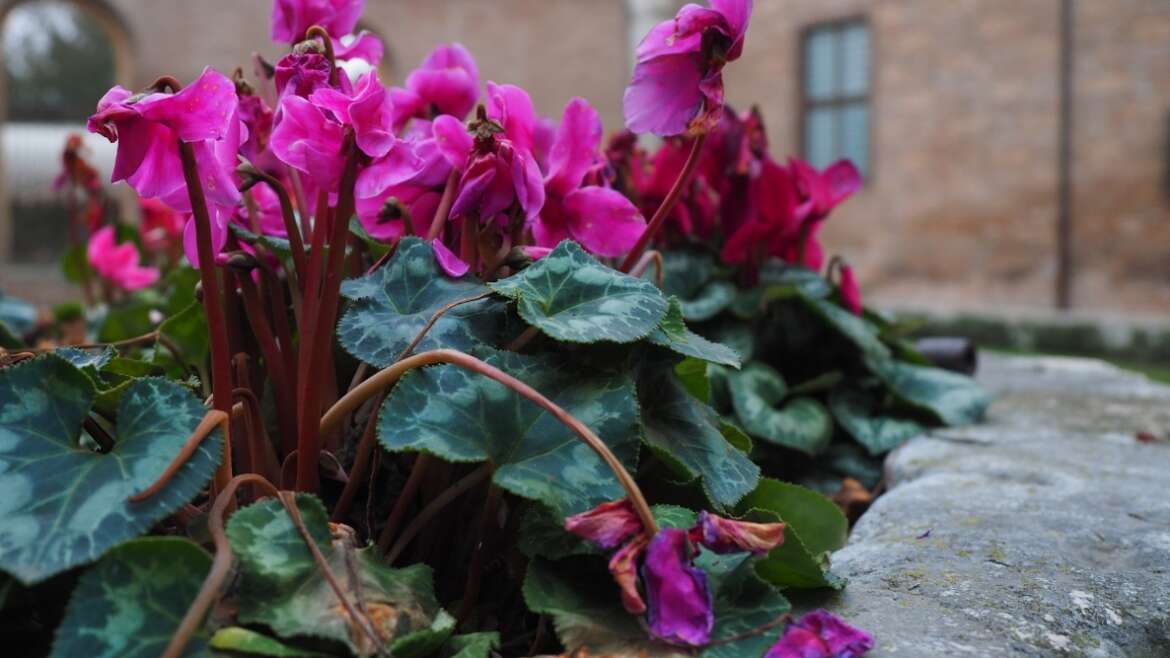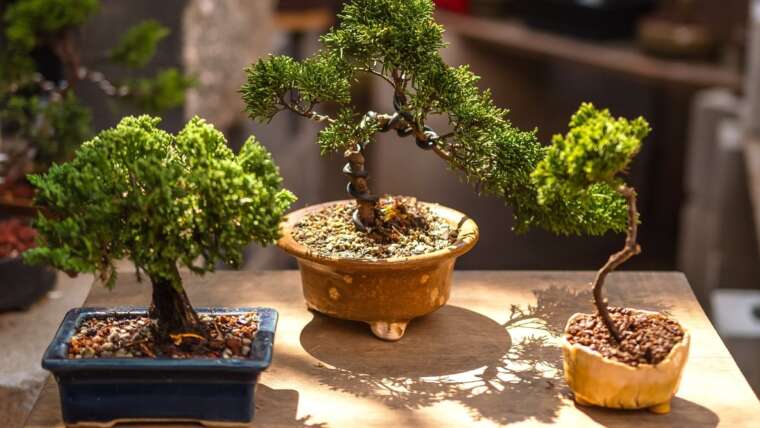Cyclamen offers gorgeous colors during the dreariest part of the year. While the world outside is free of foliage, cold, and covered in snow, this winter bloomer lightens the mood with pretty pink, white, purple, and red blooms with deep green and white foliage. You’ll want those unforgettable blooms repeatedly, which may be more complicated than you bargained for.
Many cyclamen owners throw out their plants after the foliage drops and blooming stops. Instead, you can keep your cyclamen and get it to flower again! While these plants will rebloom, they require the right care to make it happen.
If you can keep your cyclamen happy during its summer dormancy, it’ll likely flower for you the following winter. Let me show you how to keep your plant blooming in its first year and beyond.
The Short Answer
Cyclamen has a short blooming period that usually lasts four weeks but can extend to three months with impeccable care. It needs indirect light, steady temperatures of 60-65°F during the day and 50°F at night, and consistently moist soil. It will stop blooming naturally, but insufficient water, light, and temperature can make it stop early.
Cyclamen goes dormant in late spring or early summer. It’ll lose all its leaves, but they’ll return in fall. Dormancy requires little to no water or fertilizer and warm temperatures.
The Long Answer
Knowing that improper sun and water can stop cyclamen from blooming isn’t enough—you need to know the specifics to ensure you’re giving your plants everything they need. Let’s consider possible reasons why your cyclamen isn’t blooming.
1. It’s Following the Natural Cycle
Cyclamen blooms for four weeks to three months; you may deadhead it to extend its flowering time.
If you’ve been enjoying cyclamen flowers for a while and they stopped, it’s likely just part of its natural cycle. All plants stop their blooming phase at some point, and the bloom period of cyclamen can seem a little on the short side, leaving you to wonder if something is wrong.
This plant blooms anywhere from four weeks to three months, depending on the variety and how you care for it. You can help your plant last longer by deadheading spent blooms.
As soon as a flower starts to fade, pluck it off the plant. It will encourage the plant to grow new blooms and will help your plant last as long as possible.
Not Enough Sunlight
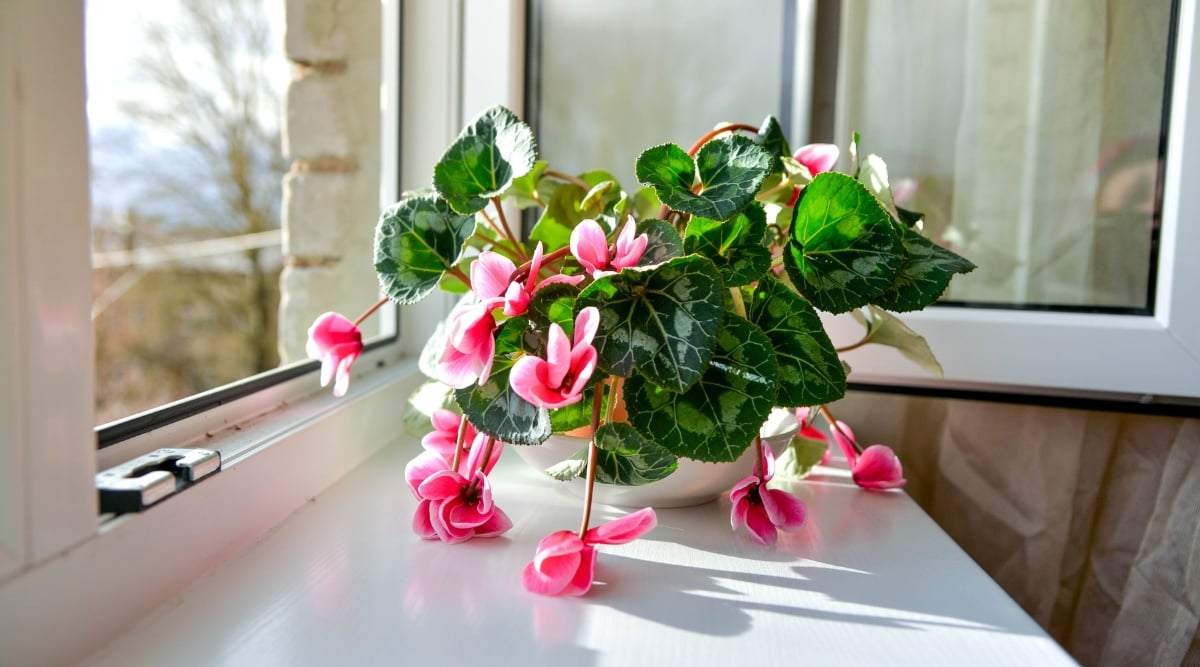 Keep cyclamen indoors and provide bright indirect light by placing it near a north-facing window.
Keep cyclamen indoors and provide bright indirect light by placing it near a north-facing window.
Cyclamen is typically kept as an indoor plant in the US. It’s easy to underestimate how much light your plant needs. It needs bright indirect light, which is a little abstract and is open to a subjective interpretation.
Based on guidance from the University of Florida, bright indirect light means being by a north-facing window but not receiving any direct rays of light.
Cyclamen is native to sloping forests where they don’t get direct sunlight. However, these areas are still pretty bright. If your plant is in a room predominantly lit by artificial lighting with very little natural light, it’s likely not getting enough and needs to be moved to a different location.
Too Much or Too Little Water
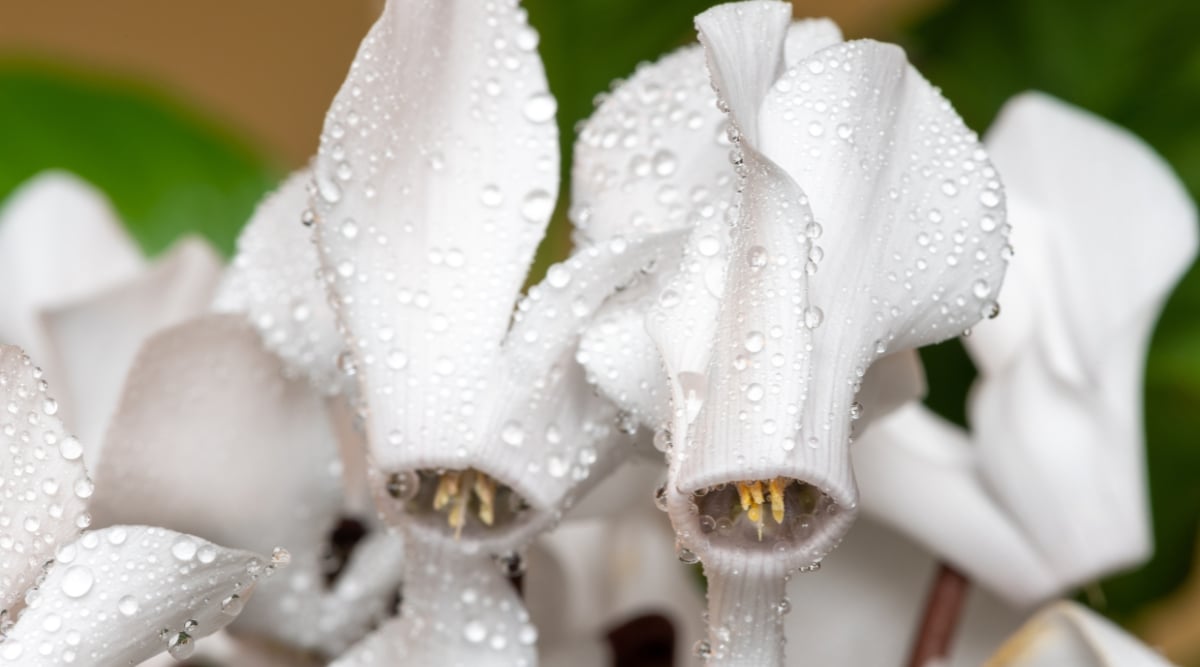 Water cyclamen when the top inches of soil are dry, but avoid wetting the crown to prevent rot.
Water cyclamen when the top inches of soil are dry, but avoid wetting the crown to prevent rot.
Watering may seem like a balancing act if you’re inexperienced with cyclamen, but it’s important to get it right. Cyclamens prefer consistent moisture. Water whenever the first few inches of soil are dry to the top. Even better, bottom water by placing your plant in a tray or dish of water, allowing it to absorb moisture via the roots.
However, too much water can cause problems, too. (Balancing act, remember?) Avoid getting the crown wet or leaving the roots in drenched soil because this can cause rot. Water along the edges of the container, avoiding the crown completely. Once the edges are dry, water again. If bottom-watering, don’t leave the pot sitting in the water for more than an hour, as it can become oversaturated.
The Temperature Isn’t Right
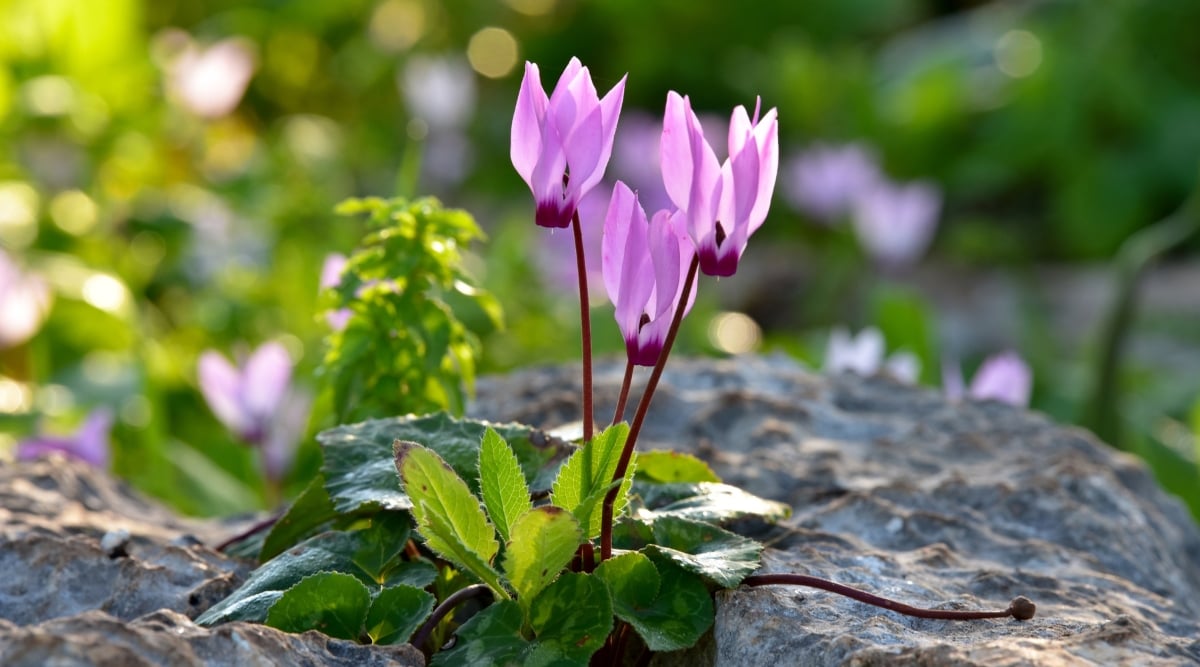 Maintain cyclamen temperature between 50-70°F for proper bud development.
Maintain cyclamen temperature between 50-70°F for proper bud development.
Getting the temperatures right is crucial, or your cyclamen won’t bloom. The plant won’t develop buds if the temperature exceeds 70°F or below 50°F. The ideal daytime temperature is 60-65°F.
Depending on the time of year, this may be difficult to achieve in your home, so keep a thermometer near your plant. If you struggle to keep cool enough temperatures in the winter, try keeping it in a separate room without a heater.
Dormancy Didn’t Go Well
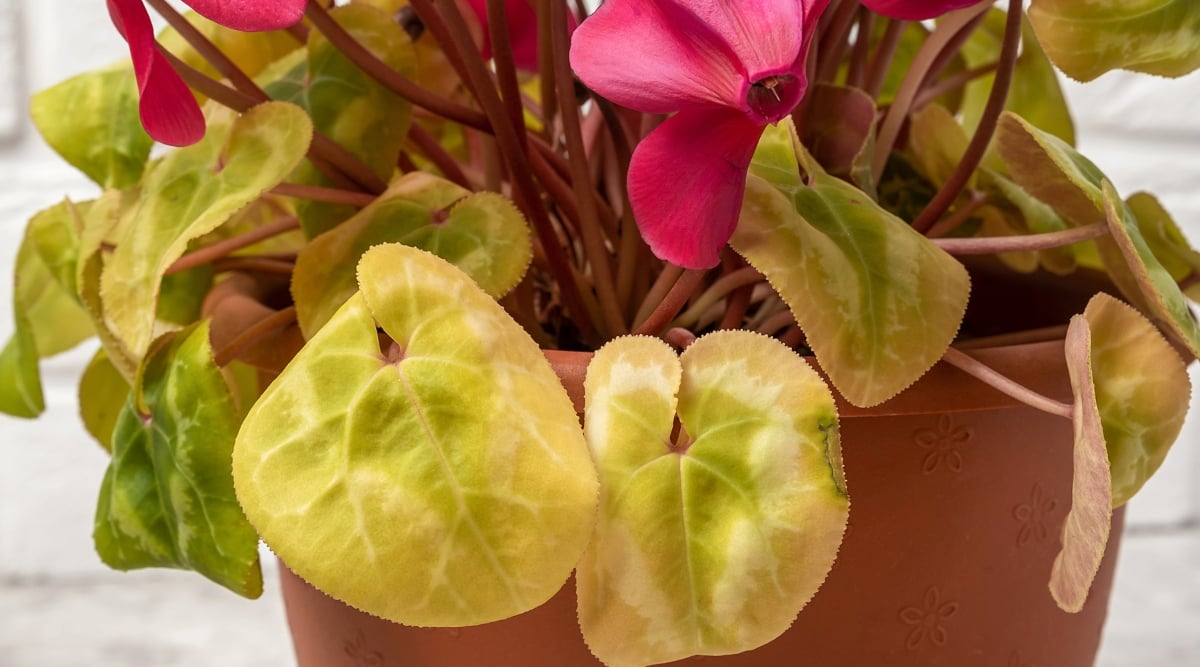 During dormancy, reduce water and keep your plant in a cool, dry place.
During dormancy, reduce water and keep your plant in a cool, dry place.
You don’t sleep well without your preferred conditions, and neither do cyclamen. While they may not require a cold room and a blanket with rain sounds, they have a checklist of things they need during dormancy. Failure to get it right may result in a lack of blooms this winter.
Cyclamen goes dormant for up to three months in the summer. In late spring, blooming will stop if it hasn’t already, and the leaves will turn yellow and drop off. Once this process begins, it’s time to switch to the dormancy care routine.
Reduce the water and fertilizer you give since they need very little while dormant. If outside temps are warmer than 50°F, set it outside in the shade. Bring the plant indoors when it rains so the soil doesn’t become soggy. If setting it outdoors isn’t an option, you can store it indoors in vermiculite for up to 12 weeks at around 50°F and repot it into the soil in autumn.
It’s Planted Too Deep
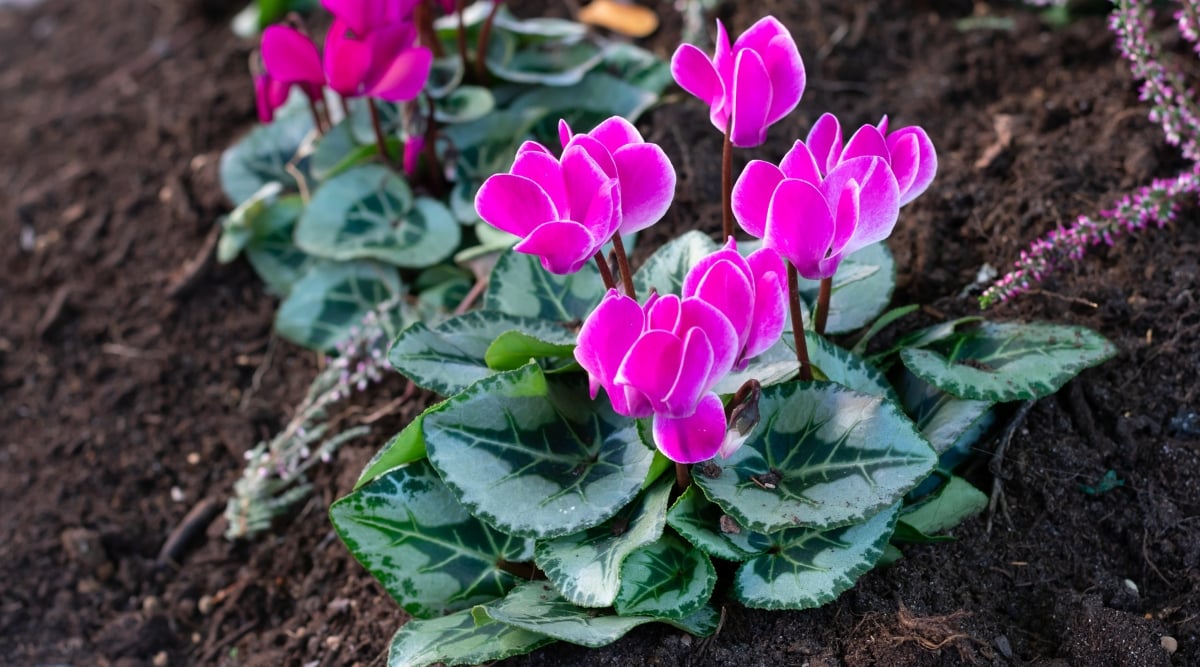 Plant cyclamen tubers 1-2 inches deep; wait for roots to develop before planting for correct orientation.
Plant cyclamen tubers 1-2 inches deep; wait for roots to develop before planting for correct orientation.
Cyclamen are sensitive about how deeply they’re planted. When you plant the tubers, they should be 1-2 inches deep, ensuring they’re no deeper than two inches. Planting too deep will cause the flowers not to bloom.
Wait until the tuber develops roots before you plant it so you can tell which end is up. If you put the root side up, you may not get much growth at all.
The Wrong Fertilizer
 Fertilize cyclamen every two weeks with a low-nitrogen fertilizer to promote blooms, not just foliage.
Fertilize cyclamen every two weeks with a low-nitrogen fertilizer to promote blooms, not just foliage.
Nitrogen is necessary for plant growth. When you add nitrogen fertilizer, you help the plant develop gorgeous green stems and leaves. But too much nitrogen will result in a lack of flowers.
Give cyclamen a fertilizer low in nitrogen every two weeks during the active growth periods in autumn. This will encourage the plant to produce flowers instead of green, leafy growth. If you think you fed it too much, skip a round of fertilizing to see how it does. If you did way too much, you may need to repot the plant into clean soil.
It’s Not Time Yet
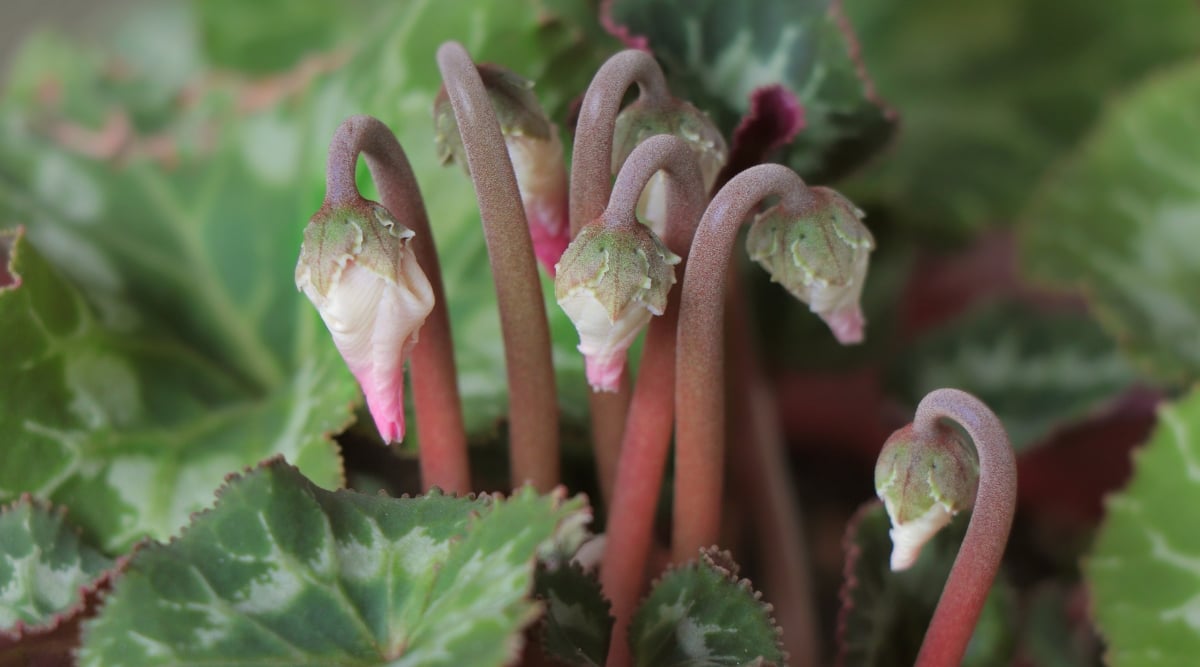 Cyclamen evolved in a Mediterranean climate, with dormancy in summer and flowering in winter and spring.
Cyclamen evolved in a Mediterranean climate, with dormancy in summer and flowering in winter and spring.
Cyclamen are adapted to a Mediterranean climate and function according to that climate, even if it’s in your home. It will be dormant when it’s hot and dry in the summer and flower in the rainy season, which is in winter and early spring for its native habitat.
Your plant will wake up around September and start growing new foliage. If you’re eagerly wondering where the flowers are, it may not be time yet. You likely won’t see flowers until December or January. It may be tough to wait for, but at least you’ll have some pretty flowers during the coldest part of the year. Remember to keep your cyclamen indoors and out of the chilly weather!
Final Thoughts
Cyclamen are beautiful flowering houseplants that are finicky about reblooming. Proper care will provide the ideal conditions to encourage your plant to flower again and again.
Ensure your cyclamen receives the right amount of water, optimal temperatures, and the right amount of sunlight, as well as a happy dormancy. It might sound like a lot of work, but all will be worth it when the pretty colors brighten the winter again.


